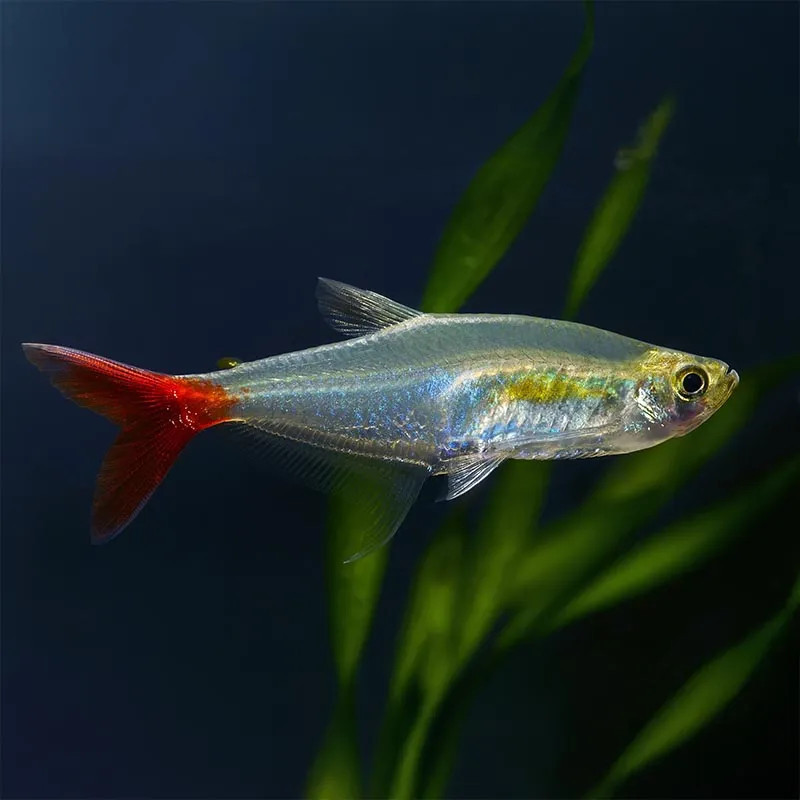Stocks Available
Filligree Bloodfin Tetra
SKU:118943
PRIONOBAMA FILIGERA
1 INCH

Stock Available
Introduction • Common Names: Bloodfin Tetra, Glass Bloodfin Tetra • Family: Characidae • Native Habitat: Found in the freshwater rivers and streams of South America, primarily in Argentina. Physical Characteristics • Appearance: Bloodfin Tetras are known for their translucent, silver bodies with a distinctive red coloration on their fins, giving them their "bloodfin" name. The contrast between their transparent body and vibrant fins makes them stand out in a community tank. • Size: These fish are relatively small, growing up to 2 inches (5 cm) in length. • Lifespan: With proper care, they can live for about 5 to 8 years in a well-maintained aquarium. Habitat Requirements • Tank Size: A 20-gallon tank is recommended for a small school, though they thrive better in larger tanks where they have more swimming space. • Water Conditions: o Temperature: They prefer water temperatures between 64-82°F (18-28°C), making them more tolerant of cooler waters compared to many other tropical species. o pH: Bloodfin Tetras thrive in neutral to slightly acidic water, with a pH range of 6.0 to 8.0. o Water Hardness: They can adapt to a range of water hardness, from soft to moderately hard (5-20 dGH). • Aquascaping: They enjoy a well-planted tank with ample swimming space in the middle and upper levels. Adding driftwood, rocks, and hiding spots replicates their natural habitat and makes them feel more secure. Diet • Primary Diet: Bloodfin Tetras are omnivores, and their primary diet should include high-quality flake food or micro pellets. • Supplemental Feeding: To enhance their health and coloration, provide a varied diet including live or frozen foods such as brine shrimp, daphnia, and bloodworms. • Feeding Frequency: Feed them small amounts twice a day, ensuring that all food is consumed within a few minutes. Behavior and Compatibility • Temperament: Bloodfin Tetras are peaceful and active schooling fish that should be kept in groups of at least 6 to reduce stress and encourage natural behavior. In a group, they swim together, often in the upper and middle regions of the tank. • Suitable Tank Mates: They do well in community tanks with other peaceful species like tetras, rasboras, Corydoras, and small peaceful fish. Their activity can help bring liveliness to a tank. • Incompatibilities: Avoid keeping them with large, aggressive fish that might see them as prey, such as cichlids or large catfish. Care Level • Difficulty: Bloodfin Tetras are hardy and adaptable, making them a good choice for beginner aquarists. They are less sensitive to water quality changes but still require a stable environment. • Maintenance: Regular water changes of about 20-30% weekly are essential for maintaining water quality. A well-functioning filtration system is also necessary to keep the water clean and free of harmful toxins. Breeding • Reproduction: Bloodfin Tetras are egg scatterers and can breed in home aquariums with the right conditions. • Breeding Tank: A separate breeding tank with fine-leaf plants or spawning mops is ideal. Keep the water slightly cooler (around 75°F or 24°C) and soft to encourage spawning. • Breeding Behavior: The female will scatter eggs, which the male fertilizes. Remove the adults after spawning to prevent them from eating the eggs. • Fry Care: The eggs hatch within 24 to 36 hours, and the fry become free-swimming after a few days. Feed them infusoria or liquid fry food initially, followed by finely crushed flakes or baby brine shrimp. Health and Disease • Common Issues: Bloodfin Tetras are hardy but can be susceptible to common freshwater diseases like ich, fin rot, and fungal infections if kept in poor conditions. • Prevention: Maintain clean water and stable water parameters, and avoid overcrowding to keep them healthy. A varied diet also supports their immune system. Conservation and Sustainability • Wild Population: Bloodfin Tetras are abundant in the wild and are also widely bred in captivity for the aquarium trade. • Conservation Status: They are not considered at risk in their natural habitat, and sustainable breeding practices ensure that captive populations are available without impacting wild populations. Conclusion The Bloodfin Tetra is an attractive, hardy, and active schooling fish that brings vibrancy to any community aquarium. Their ease of care and adaptability make them a great option for both novice and experienced aquarists. By maintaining proper water conditions, providing a well-balanced diet, and offering a suitable tank environment, Bloodfin Tetras can thrive and live long, healthy lives in a home aquarium.
Data sheet
16 other products in the same category:
Customers who bought this product also bought: